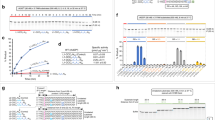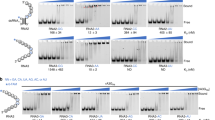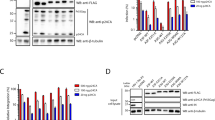Abstract
HIV-1 deleted for the vif accessory gene encapsidates the cellular cytidine deaminase APOBEC3G. Upon infection, the encapsidated APOBEC3G induces G→A mutations in the viral reverse transcripts. The G→A mutations result either from C→U deamination of the minus strand or deamination of both strands followed by repair of the plus strand. We report here that minus-strand deamination occurred over the length of the virus genome, preferentially at CCCA sequences, with a graded frequency in the 5′→3′ direction. APOBEC3G induced previously undetected C→T mutations in the 5′ U3 and the primer-binding site, both of which become transiently single-stranded during reverse transcription. In vitro, APOBEC3G bound and deaminated single-stranded DNA (ssDNA) but not double-stranded DNA (dsDNA) or DNA-RNA hybrids. We propose that the requirement for ssDNA accounts for the minus-strand mutations, the 5′→3′ graded frequency of deamination and the rare C→T mutations.
This is a preview of subscription content, access via your institution
Access options
Subscribe to this journal
Receive 12 print issues and online access
$259.00 per year
only $21.58 per issue
Buy this article
- Purchase on SpringerLink
- Instant access to full article PDF
Prices may be subject to local taxes which are calculated during checkout





Similar content being viewed by others
References
Strebel, K. et al. The HIV 'A' (sor) gene product is essential for virus infectivity. Nature 328, 728–730 (1987).
von Schwedler, U., Song, J., Aiken, C. & Trono, D. Vif is crucial for human immunodeficiency virus type 1 proviral DNA synthesis in infected cells. J. Virol. 67, 4945–4955 (1993).
Gabuzda, D.H. et al. Role of vif in replication of human immunodeficiency virus type 1 in CD4+ T lymphocytes. J. Virol. 66, 6489–6495 (1992).
Madani, N. & Kabat, D. An endogenous Inhibitor of human immunodeficiency virus in human lymphocytes is overcome by the viral Vlf protein. J. Virol. 72, 10251–10255 (1998).
Simon, J.H. et al. The regulation of primate immunodeficiency virus infectivity by Vlf is cell species restricted: a role for Vlf in determining virus host range and cross-species transmission. EMBO J. 17, 1259–1267 (1998).
Sheehy, A.M., Gaddis, N.C., Choi, J.D. & Malim, M.H. Isolation of a human gene that inhibits HIV-1 infection and is suppressed by the viral Vif protein. Nature 418, 646–650 (2002).
Goncalves, J., Korin, Y., Zack, J. & Gabuzda, D. Role of Vif in human immunodeficiency virus type 1 reverse transcription. J. Virol. 70, 8701–8709 (1996).
Simon, J.H. & Malim, M.H. The human immunodeficiency virus type 1 Vif protein modulates the postpenetration stability of viral nucleoprotein complexes. J. Virol. 70, 5297–5305 (1996).
Mariani, R. et al. Species-specific exclusion of APOBEC3G from HIV-1 virions by Vif. Cell 114, 21–31 (2003).
Lecossier, D., Bouchonnet, F., Clavel, F. & Hance, A.J. Hypermutation of HIV-1 DNA in the absence of the Vif protein. Science 300, 1112 (2003).
Zhang, H. et al. The cytidine deaminase CEM15 induces hypermutation in newly synthesized HIV-1 DNA. Nature 424, 94–98 (2003).
Mangeat, B. et al. Broad antiretroviral defence by human APOBEC3G through lethal editing of nascent reverse transcripts. Nature 424, 99–103 (2003).
Harris, R.S. et al. DNA deamination mediates innate immunity to retroviral infection. Cell 113, 803–809 (2003).
Stopak, K., de Noronha, C., Yonemoto, W. & Greene, W.C. HIV-1 Vif blocks the antiviral activity of APOBEC3G by impairing both its translation and intracellular stability. Mol. Cell 12, 591–601 (2003).
Marin, M., Rose, K.M., Kozak, S.L. & Kabat, D. HIV-1 Vif protein binds the editing enzyme APOBEC3G and induces its degradation. Nat. Med. 9, 1398–1403 (2003).
Yu, X. et al. Induction of APOBEC3G ubiquitination and degradation by an HIV-1 Vif-Cul5-SCF complex. Science 302, 1056–1060 (2003).
Sheehy, A.M., Gaddis, N.C. & Malim, M.H. The antiretroviral enzyme APOBEC3G is degraded by the proteasome in response to HIV-1 Vif. Nat. Med. 9, 1404–1407 (2003).
Jarmuz, A. et al. An anthropoid-specific locus of orphan C to U RNA-editing enzymes on chromosome 22. Genomics 79, 285–296 (2002).
Harris, R.S., Petersen-Mahrt, S.K. & Neuberger, M.S. RNA editing enzyme APOBEC1 and some of its homologs can act as DNA mutators. Mol. Cell 10, 1247–1253 (2002).
Yang, Y., Sowden, M.P. & Smith, H.C. Induction of cytidine to uridine editing on cytoplasmic apolipoprotein B mRNA by overexpressing APOBEC-1. J. Biol. Chem. 275, 22663–22669 (2000).
Lau, P.P. et al. A DnaJ protein, apobec-1-binding protein-2, modulates apolipoprotein B mRNA editing. J. Biol. Chem. 276, 46445–46452 (2001).
Anant, S., MacGinnitie, A.J. & Davidson, N.O. apobec-1, the catalytic subunit of the mammalian apolipoprotein B mRNA editing enzyme, is a novel RNA-binding protein. J. Biol. Chem. 270, 14762–14767 (1995).
Muto, T., Muramatsu, M., Taniwaki, M., Kinoshita, K. & Honjo, T. Isolation, tissue distribution, and chromosomal localization of the human activation-induced cytidine deaminase (AID) gene. Genomics 68, 85–88 (2000).
Wedekind, J.E., Dance, G.S., Sowden, M.P. & Smith, H.C. Messenger RNA editing in mammals: new members of the APOBEC family seeking roles in the family business. Trends Genet. 19, 207–216 (2003).
Petersen-Mahrt, S.K., Harris, R.S. & Neuberger, M.S. AID mutates E. coli suggesting a DNA deamination mechanism for antibody diversification. Nature 418, 99–103 (2002).
Schrofelbauer, B., Chen, D. & Landau, N.R. A single amino acid of APOBEC3G controls its species-specific interaction with virion infectivity factor (Vif). Proc. Natl. Acad. Sci. USA 101, 3927–3932 (2004).
Schroder, A.R. et al. HIV-1 integration in the human genome favors active genes and local hotspots. Cell 110, 521–529 (2002).
Dickerson, S.K., Market, E., Besmer, E. & Papavasiliou, F.N. AID mediates hypermutation by deaminating single-stranded DNA. J. Exp. Med. 197, 1291–1296 (2003).
Charneau, P. & Clavel, F. A single-stranded gap in human immunodeficiency virus unintegrated linear DNA defined by a central copy of the polypurine tract. J. Virol. 65, 2415–2421 (1991).
Vartanian, J.P., Henry, M. & Wain-Hobson, S. Sustained G→A hypermutation during reverse transcription of an entire human immunodeficiency virus type 1 strain Vau group O genome. J. Gen. Virol. 83, 801–805 (2002).
Borman, A.M., Quillent, C., Charneau, P., Kean, K.M. & Clavel, F. A highly defective HIV-1 group O provirus: evidence for the role of local sequence determinants in G→A hypermutation during negative-strand viral DNA synthesis. Virology 208, 601–609 (1995).
Berkhout, B. & van Hemert, F.J. The unusual nucleotide content of the HIV RNA genome results in a biased amino acid composition of HIV proteins. Nucleic Acids Res. 22, 1705–1711 (1994).
Berkhout, B., Grigoriev, A., Bakker, M. & Lukashov, V.V. Codon and amino acid usage in retroviral genomes is consistent with virus-specific nucleotide pressure. AIDS Res. Hum. Retroviruses 18, 133–141 (2002).
Paxton, W., Connor, R.I. & Landau, N.R. Incorporation of Vpr into human immunodeficiency virus type-1 virions: requirement for the p6 region of gag and mutational analysis. J. Virol. 67, 7229–7237 (1993).
Rose, P.P. & Korber, B.T. Detecting hypermutations in viral sequences with an emphasis on G→A hypermutation. Bioinformatics 16, 400–401 (2000).
Petersen-Mahrt, S.K. & Neuberger, M.S. In vitro deamination of cytosine to uracil in single-stranded DNA by apolipoprotein B editing complex catalytic subunit 1 (APOBEC1). J. Biol. Chem. 278, 19583–19586 (2003).
Acknowledgements
We thank D. Chen, R. Mariani and B. Schröfelbauer for laboratory assistance. This work was funded by the US National Institutes of Health (AI058864, DA014494, AI27670, AI38858, AI43638, AI36214 and AI29164), the Universitywide AIDS Research Program of California (IS02-SI-704 and F03-SIBS-215), the Elizabeth Glaser Pediatric AIDS Foundation (EGPAF 28-PF-77491) and the Research Center for AIDS and HIV Infection of the San Diego Veterans Affairs Healthcare System. N.R.L. is an Elizabeth Glaser Scientist of the Pediatric AIDS Foundation.
Author information
Authors and Affiliations
Corresponding author
Ethics declarations
Competing interests
The authors declare no competing financial interests.
Rights and permissions
About this article
Cite this article
Yu, Q., König, R., Pillai, S. et al. Single-strand specificity of APOBEC3G accounts for minus-strand deamination of the HIV genome. Nat Struct Mol Biol 11, 435–442 (2004). https://doi.org/10.1038/nsmb758
Received:
Accepted:
Published:
Issue date:
DOI: https://doi.org/10.1038/nsmb758
This article is cited by
-
APOBEC3-mediated mutagenesis in cancer: causes, clinical significance and therapeutic potential
Journal of Hematology & Oncology (2023)
-
Antiretroviral APOBEC3 cytidine deaminases alter HIV-1 provirus integration site profiles
Nature Communications (2023)
-
Structural basis of sequence-specific RNA recognition by the antiviral factor APOBEC3G
Nature Communications (2022)
-
Immune escape mutations in HIV-1 controllers in the Brazilian Amazon region
BMC Infectious Diseases (2020)
-
Defective viral genomes are key drivers of the virus–host interaction
Nature Microbiology (2019)



